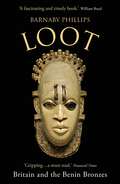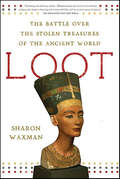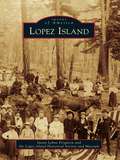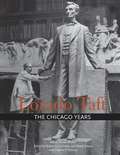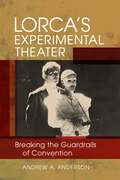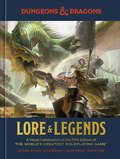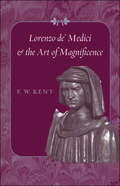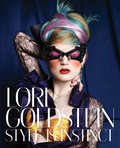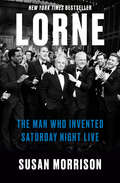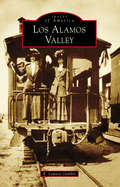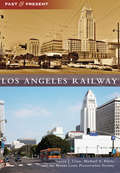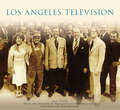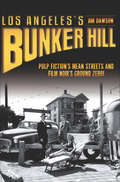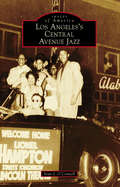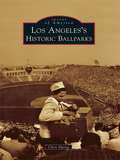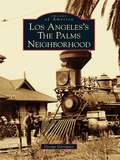- Table View
- List View
Loot: Britain and the Benin Bronzes (Modern Classics Ser.)
by Barnaby Phillips&‘A fascinating and timely book.&’ William Boyd &‘Gripping…a must read.&’ FT In 1897, Britain responded to the killing of a group of officials by razing an empire to the ground. The men had been travelling to the ancient Kingdom of Benin, in what is now Nigeria, when they were ambushed and killed by local soldiers. Just six weeks later, the British had exacted their revenge, set Benin aflame, exiled the king and annexed the territory. They also made off with some of Africa&’s greatest works of art.This is the story of the &‘Benin Bronzes&’, their creation, removal, and what should happen to them now. When first exhibited in London they caused a sensation and helped reshape European attitudes towards Africa, challenging the prevailing view of the continent as &‘backward&’ and without culture. But seeing them in the British Museum today is, in the words of one Benin City artist, like &‘visiting relatives behind bars&’. In a time of fevered debate about the legacies of empire, loot, museums and history, what does the future hold for the Bronzes themselves?
Loot: The Battle Over the Stolen Treasures of the Ancient World
by Sharon WaxmanA journey across four continents to the heart of the conflict over who should own the great works of ancient artWhy are the Elgin Marbles in London and not on the Acropolis? Why do there seem to be as many mummies in France as there are in Egypt? Why are so many Etruscan masterworks in America? For the past two centuries, the West has been plundering the treasures of the ancient world to fill its great museums, but in recent years, the countries where ancient civilizations originated have begun to push back, taking museums to court, prosecuting curators, and threatening to force the return of these priceless objects.Where do these treasures rightly belong? Sharon Waxman, a former culture reporter for The New York Times and a longtime foreign correspondent, brings us inside this high-stakes conflict, examining the implications for the preservation of the objects themselves and for how we understand our shared cultural heritage. Her journey takes readers from the great cities of Europe and America to Egypt, Turkey, Greece, and Italy, as these countries face down the Louvre, the Metropolitan Museum, the British Museum, and the J. Paul Getty Museum. She also introduces a cast of determined and implacable characters whose battles may strip these museums of some of their most cherished treasures.For readers who are fascinated by antiquity, who love to frequent museums, and who believe in the value of cultural exchange, Loot opens a new window on an enduring conflict.
Lopez Island
by Lopez Island Historical Society and Museum Susan Lehne FergusonThe story of Lopez Island is a story of community. Skilled, brave, generous people like Sampson Chadwick, Mother Brown, Captain Barlow, and Amelia Davis carved a spirited, nurturing community out of seaside wilderness. Homesteaders cleared forests, built farms, grew food, and raised large families, surviving then thriving together. The hamlets of Port Stanley, Richardson, and Lopez emerged, creating hubs with stores, post offices, and schools as well as thriving fishing, canning, and shipping industries. The community fostered education, music, writing, dances, chivarees, baseball, quilting, a birthday club, and grand Fourth of July celebrations. Living self-reliant lives while helping friends, neighbors, and newcomers, Lopezians created a unique community character that abides today.
Lorado Taft: The Chicago Years
by Henry Adams Robert G. La France Allen Stuart WellerSculptor Lorado Taft helped build Chicago's worldwide reputation as the epicenter of the City Beautiful Movement. In this new biography, art historian Allen Stuart Weller picks up where his earlier book Lorado in Paris left off, drawing on the sculptor's papers to generate a fascinating account of the most productive and influential years of Taft's long career. Returning to Chicago from France, Taft established a bustling studio and began a twenty-one-year career as an instructor at the Art Institute, succeeded by three decades as head of the Midway Studios at the University of Chicago. This triumphant era included: ephemeral sculpture for the 1893 World's Columbian Exposition; a prolific turn-of-the-century period marked by the gold-medal-winning The Solitude of the Soul; the 1913 Fountain of the Great Lakes; the 1929 Alma Mater at the University of Illinois; and large-scale projects such as his ambitious program for Chicago's Midway with the monumental Fountain of Time. In addition, the book charts Taft's mentoring of women artists, including the so-called White Rabbits at the World's Fair, many of whom went on to achieve artistic success. Lavishly illustrated with color images of Taft's most celebrated works, Lorado Taft: The Chicago Years completes the first major study of a great American artist.
Lorain (Images of America)
by The Black River Historical SocietyThe City of Lorain was incorporated in 1874 by the town council. It was named after the county, which had been named by Heman Ely, who thought the area looked very much like the Province of Lorraine in France. Lorainâ TMs location next to Lake Erie and theearly arrival of the B&O Railroad in 1871 made thecity a hotbed for industry. The Hayden Brass Worksbuilt a large plant on Elyria Avenue. Captain Thew, aship captain on the lakes, developed an improved gearsystem for a steam shovel, and that started the Lorain Thew Shovel Co., which became known worldwide.Lorain grew tremendously in the 1890s. Constructionof the Johnson Steel Rail Company started in 1894, and in just ten years, the population of the City of Lorain tripled. In 1894, the American Stove Works built a plant in Lorain, where they made heaters and furnaces. Three years later, the American Shipbuilding Company built a yard and launched hundreds of ships before it closed in 1984. Lorain, Ohio, certainly did its part during World War II; many men went into service, and Lorain produced its own share of heroes. The shipyard was also put to work by the government to build the USS Lorain, a frigate.
Lorca's Experimental Theater: Breaking the Guardrails of Convention (New Hispanisms: Cultural and Literary Studies)
by Andrew A. AndersonCritical and historical discussions of the life and work of Federico García Lorca, Spain’s foremost poet and playwright of the twentieth century, often obscure the author’s more avant-garde dramatic works. In Lorca’s Experimental Theater, Andrew A. Anderson focuses on four of Lorca’s most challenging plays—Amor de don Perlimplín con Belisa en su jardín, El público, Así que pasen cinco años, and El sueño de la vida (previously known as Comedia sin título)—and on the surrounding context in which they came to be written and in only one case performed during his lifetime. While none of Lorca’s plays can be considered conventional, these four works stand out in his corpus for challenging theatrical conventions most forcefully, both thematically and technically.With discussions of stagecraft, artistic modernism, and the historical avant-garde, Lorca’s Experimental Theater provides detailed interpretive readings of the four plays, surveys their textual and performative history, and examines the most important contemporary influences on Lorca’s creation of these expressive, innovative works.
Lords of the Fly: Madness, Obsession, And The Hunt For The World Record Tarpon
by Monte BurkeFrom the bestselling author of Saban, 4th and Goal, and Sowbelly comes the thrilling, untold story of the quest for the world record tarpon on a fly rod—a tale that reveals as much about Man as it does about the fish.In the late 1970s and early 1980s, something unique happened in the quiet little town on the west coast of Florida known as Homosassa. The best fly anglers in the world—Lefty Kreh, Stu Apte, Ted Williams, Tom Evans, Billy Pate and others—all gathered together to chase the same Holy Grail: The world record for the world&’s most glamorous and sought-after fly rod species, the tarpon. The anglers would meet each morning for breakfast. They would compete out on the water during the day, eat dinner together at night, socialize and party. Some harder than others. The world record fell nearly every year. But records weren&’t the only things that were broken. Hooks, lines, rods, reels, hearts and marriages didn&’t survive, either. The egos involved made the atmosphere electric. The difficulty of the quest made it legitimate. The drugs and romantic entaglements that were swept in with the tide would finally make it all veer out of control. It was a confluence of people and place that had never happened before in the world of fishing and will never happen again. It was a collision of the top anglers and the top species of fish which would lead to smashed lives for nearly all involved, man and fish alike. In Lords of the Fly, Burke, an obsessed tarpon fly angler himself, delves into this incredible moment. He examines the growing popularity of the tarpon, an amazing fish has been around for 50 million years, can live to 80 years old and can grow to 300 pounds in weight. It is a massive, leaping, bullet train of a fish. When hooked in shallow water, it produces &“immediate unreality,&” as the late poet and tarpon obsessive, Richard Brautigan, once described it. Burke also chronicles the heartbreaking destruction that exists as a result—brought on by greed, environmental degradation and the shenanigans of a notorious Miami gangster—and how all of it has shaped our contemporary fishery. Filled with larger-than-life characters and vivid prose, Lords of the Fly is not only a must read for anglers of all stripes, but also for those interested in the desperate yearning of the human condition.
Lordsburg and La Verne in Southern California (Postcard History)
by Marlin L. HeckmanFrom the 1890s through the 1920s, the postcard was an extraordinarily popular means of communication, and many of the postcards produced during this "golden age" can today be considered works of art. Postcard photographers traveled the length and breadth of the nation snapping photographs of busy street scenes, documenting local landmarks, and assembling crowds of local children only too happy to pose for a picture. These images, printed as postcards and sold in general stores across the country, survive as telling reminders of an important era in America's history. This fascinating history of Lordsburg and La Verne, California,showcases more than 200 of the best vintage postcards available.
Lore & Legends: A Visual Celebration of the Fifth Edition of the World's Greatest Roleplaying Game (Dungeons & Dragons) (Dungeons & Dragons)
by Michael Witwer Kyle Newman Jon Peterson Sam Witwer Official Dungeons & Dragons LicensedAn illustrated guide to Dungeons & Dragons&’ beloved fifth edition told through interviews, artwork, and visual ephemera from the designers, storytellers, and artists who bring it to life. When the reimagined fifth edition of Dungeons & Dragons debuted in the summer of 2014, the game was on the brink of obsolescence. But within a few short years, D&D found greater success than it had ever enjoyed before, even surpassing its 1980s golden age. How did an analog game nearly a half century old become a star in a digital world? For the first time, Lore & Legends reveals the incredible ongoing story of Dungeons & Dragons fifth edition from the perspective of the designers, artists, and players who bring it to life. This comprehensive visual guide illuminates contemporary D&D—its development, evolution, cultural relevance, and popularity—through exclusive interviews and more than 900 pieces of artwork, photography, and advertising curated and analyzed by the authors of the bestselling and Hugo Award–nominated Dungeons & Dragons Art & Arcana.
Lorenzo Ghiberti’s Gates of Paradise
by Amy R. BlochThis book examines the heretofore unsuspected complexity of Lorenzo Ghiberti's sculpted representations of Old Testament narratives in his Gates of Paradise (1425–52), the second set of doors he made for the Florence Baptistery and a masterpiece of Italian Renaissance sculpture. One of the most intellectually engaged and well-read artists of his age, Ghiberti found inspiration in ancient and medieval texts, many of which he and his contacts in Florence's humanist community shared, read, and discussed. He was fascinated by the science of vision, by the functioning of nature, and, above all, by the origins and history of art. These unusually well-defined intellectual interests, reflected in his famous Commentaries, shaped his approach in the Gates. Through the selection, imaginative interpretation, and arrangement of biblical episodes, Ghiberti fashioned multi-textured narratives that explore the human condition and express his ideas on a range of social, political, artistic, and philosophical issues.
Lorenzo de' Medici and the Art of Magnificence (The Johns Hopkins Symposia in Comparative History #24)
by F. W. KentIn the past half century scholars have downplayed the significance of Lorenzo de' Medici (1449–1492), called "the Magnificent," as a patron of the arts. Less wealthy than his grandfather Cosimo, the argument goes, Lorenzo was far more interested in collecting ancient objects of art than in commissioning contemporary art or architecture. His earlier reputation as a patron was said to be largely a construct of humanist exaggeration and partisan deference.Although some recent studies have taken issue with this view, no synthesis of Lorenzo as art patron and art lover has yet emerged. In Lorenzo de' Medici and the Art of Magnificence historian F. W. Kent offers a new look at Lorenzo's relationship to the arts, aesthetics, collecting, and building—especially in the context of his role as the political boss (maestro della bottega) of republican Florence and a leading player in Renaissance Italian diplomacy. As a result of this approach, which pays careful attention to the events of his short but dramatic life, a radically new chronology of Lorenzo's activities as an art patron emerges, revealing them to have been more extensive and creative than previously thought. Kent's Lorenzo was broadly interested in the arts and supported efforts to beautify Florence and the many Medici lands and palaces. His expertise was well regarded by guildsmen and artists, who often turned to him for advice as well as for patronage. Lorenzo himself was educated in the arts by such men, and Kent explores his aesthetic education and taste, taking into account what is known of Lorenzo's patronage of music and manuscripts, and of his own creative work as a major Quattrocento poet. Richly illustrated with photographs of Medici landmarks by Ralph Lieberman, Lorenzo de' Medici and the Art of Magnificence offers a masterful portrait of Lorenzo as a man whose achievements might have rivaled his grandfather's had he not died so young.
Lori Goldstein
by Lori GoldsteinA stunning anthology of the work of visionary stylist Lori Goldstein, whose interpretations of fashion and beauty have produced some of the most groundbreaking and iconic images in fashion and popular culture. Lori Goldstein: Style Is Instinct publishes for the first time in book form the work of one of the worlds most highly regarded stylists. With a foreword by Steven Meisel, it features more than eighty astounding images that she created in collaboration with the worlds finest photographers--including Annie Leibovitz, Mario Testino, Bruce Weber, Meisel, and many others--for fashion editorials, renowned advertising campaigns, and award-winning music videos. This striking volume captures Goldsteins personal credo, which has come to define her work--"everything goes with anything"--and displays her signature style, from her unique way of mixing and matching print and color to how she uses clothes to create images that go beyond glamour to the metaphysical, spiritual, and natural worlds. Four distinctive chapters--"The Sickness," "The Divine," "Harmonious Discord," and "Pop"--present these imaginative realms in alluring visual detail, accompanied by numerous personal anecdotes that provide insight into Goldsteins process of styling and her creative power, as well as the worlds of fashion, celebrity, and advertising. They highlight her talent for pushing beyond the edge of convention to create moments of individuality that transcend the norm as well as influence and transform our views on fashion, beauty, and popular culture. The publication of this extraordinary collection is a landmark in fashion and image making.
Lorna Simpson Collages
by Elizabeth Alexander Lorna Simpson"Black women's heads of hair are galaxies unto themselves, solar systems, moonscapes, volcanic interiors."—Elizabeth Alexander, from the IntroductionUsing advertising photographs of black women (and men) drawn from vintage issues of Ebony and Jet magazines, the exquisite and thought-provoking collages of world-renowned artist Lorna Simpson explore the richly nuanced language of hair. Surreal coiffures made from colorful ink washes, striking geological formations from old textbooks, and other unexpected forms and objects adorn the models to mesmerizingly beautiful effect. Featuring 160 artworks, an artist's statement, and an introduction by poet, author, and scholar Elizabeth Alexander, this volume celebrates the irresistible power of Simpson's visual vernacular.
Lorne: The Man Who Invented Saturday Night Live
by Susan MorrisonNEW YORK TIMES BESTSELLER • The definitive biography of Lorne Michaels, the man behind America&’s most beloved comedy show&“The kind of biographical monument usually consecrated to founding fathers, canonical authors and world-historical scientific geniuses.&”—The New York Times (Editors&’ Choice)&“Readers are treated to the Holy Grail for any journalist hoping to crack the show: a warts-and-all week in the life of SNL, where Morrison gets to see the real process of putting the thing together.&”—VarietyOver the fifty years that Lorne Michaels has been at the helm of Saturday Night Live, he has become a revered and inimitable presence in the entertainment world. He&’s a tastemaker, a mogul, a withholding father figure, a genius spotter of talent, a shrewd businessman, a name-dropper, a raconteur, the inspiration for Dr. Evil, the winner of more than a hundred Emmys—and, essentially, a mystery. Generations of writers and performers have spent their lives trying to figure him out, by turns demonizing and lionizing him. He&’s &“Obi-Wan Kenobi&” (Tracy Morgan), the &“great and powerful Oz&” (Kate McKinnon), &“some kind of very distant, strange comedy god&” (Bob Odenkirk).Lorne will introduce you to him, in full, for the first time. With unprecedented access to Michaels and the entire SNL apparatus, Susan Morrison takes readers behind the curtain for the lively, up-and-down, definitive story of how Michaels created and maintained the institution that changed comedy forever.Drawn from hundreds of interviews—with Michaels, his friends, and SNL&’s iconic stars and writers, from Will Ferrell to Tina Fey to John Mulaney to Chris Rock to Dan Aykroyd—Lorne is a deeply reported, wildly entertaining account of a man singularly obsessed with the show that would define his life and have a profound impact on American culture.
Los Alamos Valley
by R. Lawson GambleLos Alamos is a small town on its way to big things. It is a growing tourist destination yet retains its pastoral charm. The history of the Los Alamos Valley can be viewed as a microcosm of the history of California, for it contains within its span Chumash Indians, mission neophytes and horse herds, Spanish land grants, cattle ranches, vaqueros, bandits, oil bonanzas, a narrow-gauge railroad, fertile soil for bountiful crops, vast vineyards, tourism, and even an element of Hollywood. Its location on the Central Coast of California means sunny skies, cool evenings, and cool, damp breezes. The character and resilience of the Los Alamos Valley inhabitants, however, is the real story. Theirs is a history of intermingling cultures and races, a steadfast preservation of traditions, and a pioneer streak of stubborn perseverance in the face of natural and economic adversity. The images in this book were gathered as the result of a community effort.
Los Angeles Documentary and the Production of Public History, 1958-1977
by Joshua GlickLos Angeles Documentary and the Production of Public History, 1958–1977 explores how documentarians working between the election of John F. Kennedy and the Bicentennial created conflicting visions of the recent and more distant American past. Drawing on a wide range of primary documents, Joshua Glick analyzes the films of Hollywood documentarians such as David Wolper and Mel Stuart, along with lesser-known independents and activists such as Kent Mackenzie, Lynne Littman, and Jesús Salvador Treviño. While the former group reinvigorated a Cold War cultural liberalism, the latter group advocated for social justice in a city plagued by severe class stratification and racial segregation. Glick examines how mainstream and alternative filmmakers turned to the archives, civic institutions, and production facilities of Los Angeles in order to both change popular understandings of the city and shape the social consciousness of the nation.
Los Angeles Memorial Coliseum
by Chris EptingOpened to the public in June of 1923, the Los Angeles Memorial Coliseum can arguably be called "America's Most Historic Sports Stadium." In 1984 the Memorial Coliseum was declared a State and Federal Historic Landmark for its contributions to both the State of California and the United States. The history of this institution is captured here in over 200 vintage images.The Memorial Coliseum's history spans eight decades, playing host to two Olympiads, two Super Bowls, one World Series, a multitude of concerts and political rallies, a Papal mass, and one of the most famous Democratic presidential nomination acceptance speeches of the 20th century by John F. Kennedy. Using photographs culled from its archives, pictured here are never-before-seen photographs of the Coliseum's construction; rare images of political and religious rallies held at the Stadium and the Los Angeles Sports Arena, and home to famous speeches by Franklin Roosevelt, Martin Luther King Jr., and Nelson Mandela; and a myriad of other sporting and entertainment events hosted by the Memorial Coliseum, including the Los Angeles Dodgers, motocross racing, and the Rolling Stones.
Los Angeles Railway (Past and Present)
by Steven J. Crise Michael A. Patris the Mount Lowe Preservation SocietyThe Los Angeles Railway's Yellow Cars, a system cobbled together from numerous horse-powered lines, cable car lines, and upstart narrow-gauge trolley companies, served downtown and its environs in some iteration from 1898 to 1963. Henry Huntington assembled this conglomerate, making it functionally effective and well patronized.
Los Angeles Sports Memories (Sports)
by Doug KrikorianFor five decades, distinguished sportswriter Doug Krikorian chronicled LA's most transcendent sports moments. Revisit revered columns enshrining iconic achievements like when rookie Magic Johnson scored forty-two points and collected fifteen rebounds, leading the Lakers to the NBA title against the Philadelphia 76ers. Celebrate with the Angels all over again after their 2002 World Series victory. Reflect on momentous stories featuring Eric Dickerson, Wayne Gretzky, Muhammad Ali and many other illustrious personalities. From Wilt Chamberlain and Kareem Abdul-Jabbar's fervent feud to Dodger Kirk Gibson's legendary game-winning 1988 World Series opener home run, relive the triumphs and tribulations of one of America's marquee sports towns.
Los Angeles Television
by Joel Tator The Museum of Broadcast CommunicationsLos Angeles television history began in the small room of an auto dealership in 1931. Since then, much of the nation's television history has been made here: the first television helicopter, the first big story that television broke before newspapers, the first live coverage of an atomic bomb, and the careers of numerous icons like Betty White, Steve Allen, Liberace, Lawrence Welk, and Tennessee Ernie Ford. Many Los Angeles television personalities went on to network fame, including Tom Snyder, Tom Brokaw, Bryant Gumbel, Connie Chung, Maury Povich, Bob Barker, Bill Leyden, Ann Curry, Pat Sajak, and Regis Philbin. Readers will discover, in many untold stories, the origins of that curious building on top the Hollywood sign, Albert Einstein's must-see local program, Marilyn Monroe's video debut, a popular television star's last tragic performance, and the actual identities of legends Korla Pandit and Iron Eyes Cody. Also in these pages is the reveal of the Mystery Tower Sitter, the all-night amateur show, the big Las Vegas premiere telecast that was blown off the air, and the treasured performer who worked at one station for 65 years.
Los Angeles's Bunker Hill: Pulp Fiction's Mean Streets and Film Noir's Ground Zero!
by Jim DawsonAn illustrated history of the iconic Hollywood neighborhood featured in numerous film noir classics—and the shadowy story of how it disappeared. When postwar movie directors went looking for a gritty location to shoot their psychological crime thrillers, they found Bunker Hill, a neighborhood of fading Victorians, flophouses, tough bars, stairways, and dark alleys in downtown Los Angeles. Novelist Raymond Chandler had already used its real-life mean streets to lend authenticity to his hardboiled detective stories featuring Philip Marlowe. But the biggest crime of all was going on behind the scenes, run by the city&’s power elite. And Hollywood just happened to capture it on film. Using nearly eighty photos, writer Jim Dawson sheds new light on Los Angeles history with this grassroots investigation of a vanished place.
Los Angeles's Central Avenue Jazz
by Sean J. O'ConnellFrom the late 1910s until the early 1950s, a series of aggressive segregation policies toward Los Angeles's rapidly expanding African American community inadvertently led to one of the most culturally rich avenues in the United States. From Downtown Los Angeles to the largely undeveloped city of Watts to the south, Central Avenue became the center of the West Coast jazz scene, nurturing homegrown talents like Charles Mingus, Dexter Gordon, and Buddy Collette while also hosting countless touring jazz legends such as Duke Ellington, Louis Armstrong, and Billie Holiday. Twenty-four hours a day, the sound of live jazz wafted out of nightclubs, restaurants, hotel lobbies, music schools, and anywhere else a jazz combo could squeeze in its instruments for nearly 50 years, helping to advance and define the sound of America's greatest musical contribution.
Los Angeles's Historic Ballparks (Images of America)
by Chris EptingBaseball's long and storied history in Los Angeles has been played at venues including the turn-of-the-century Chutes Park, which was part of an amusement park, as well as Gilmore Field, where the Hollywood Stars played, and Wrigley Field, where many movies and television shows were filmed. The 1923-vintage Los Angeles Memorial Coliseum became the Dodgers' first home in California in 1958, when they moved from Brooklyn. Greater Los Angeles also featured professional baseball at Olive Memorial Stadium in Burbank, Brookside Park in Pasadena, on Catalina Island, plus at numerous diamonds throughout Orange and Riverside Counties, where legends including Babe Ruth, Joe DiMaggio, and Connie Mack appeared. Most fans know Dodger Stadium and Angel Stadium, but many other historic ballparks existed in Southern California. Their images are collected together here for the first time.
Los Angeles's Little Tokyo (Images of America)
by Little Tokyo Historical SocietyIn 1884, a Japanese sailor named Hamanosuke Shigeta made his way to the eastern section of downtown Los Angeles and opened Little Tokyo's first business, an American-style café. By the early 20th century, this neighborhood on the banks of the Los Angeles River had developed into a vibrant community serving the burgeoning Japanese American population of Southern California. When Japanese Americans were forcibly removed to internment camps in 1942 following the attack on Pearl Harbor and the United States' entrance into World War II, Little Tokyo was rechristened "Bronzeville" as a newly established African American enclave popular for its jazz clubs and churches. Despite the War Relocation Authority's opposition to re-establishing Little Tokyo following the war, Japanese Americans gradually restored the strong ties evident today in 21st-century Little Tokyo--a multicultural, multigenerational community that is the largest Nihonmachi (Japantown) in the United States.
Los Angeles's The Palms Neighborhood
by George GarriguesThe Westside neighborhood of Palms is the oldest suburb of Los Angeles. Founded in 1886 halfway between L.A. and the beach on a steam railroad line, Palms attracted wealthy Angelinos escaping the summer's downtown heat as well as Easterners seeking a new life in "the natural home of the fig, olive, lemon, lime, apricot, and that class of fruit that brings the largest profit in the local market." Rancho Park and Mar Vista had yet to make it onto maps--it was all "The Palms." The school district stretched from the Santa Monica Mountains on the north toward Redondo Beach on the south. A lively social and business life sprang up, but gradually the metropolis enfolded Palms, which was annexed into Los Angeles in 1915. After World War II, subdivisions brought young families, the flatlands became a huge swath of apartments, and the barren hill area became the tree-shrouded Westside Village.
